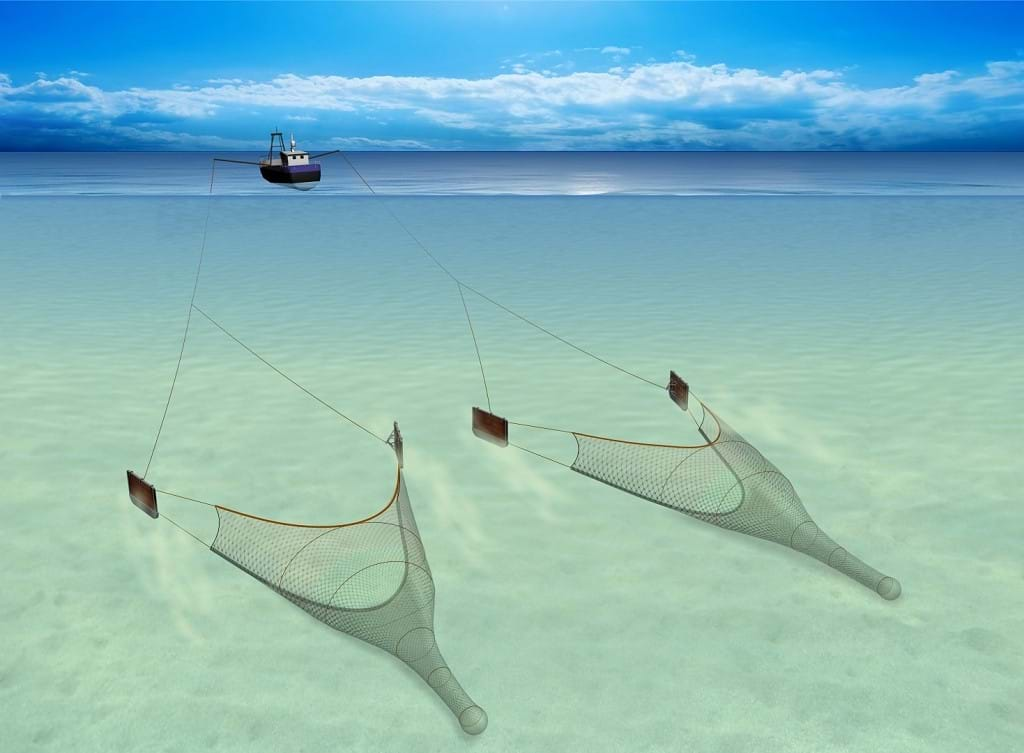Out-rig Trawling
Alternative names
-
- Australian twin rig
- Gulf of Mexico shrimp rig
Summary
Out-rig trawling is a method of multi rig trawling where two small otter trawls with the nets close behind them, are towed from the ends of outrigger derricks in a similar way to how a beam trawler tows its gear.

Environmental impact
In comparison to the beam trawls that the vessel would normally tow, the out-rig gear and nets will be considerably lighter resulting in decreased seabed impact. This gear will have a slightly wider foot print on the seabed but it has to be towed slower than the same vessel would tow its beam trawls resulting in decrease in fuel usage. There will be some weight impact and shearing action from the doors on the seabed but it will be much less than a standard beam trawl and much the same as other otter trawling methods.
The gear is designed to target bottom living fish as a result of its low headline height. The trawls are similar to sole trawls in that they are towed from the top and bottom aft corners of the trawl doors, this dictates the height of the headline of the trawl, usually no more than 800mm. This reduces the possibility of round fish by catch. one of the negatives with this gear is that it allows some of the large beam trawls into sea areas where they cannot go with their beam trawls, this has led to some gear conflict in the past.
Other information
Out-rig trawling is a method of multi rig trawling where two small trawls are towed from the ends of out-rigger derricks in a similar way that a beam trawler tows its gear. In many cases, it can be as simple as replacing the two beam trawls with two small otter trawls. This is a direct adaption from the rig used in Australian prawn fishery and the shrimp fishery in the Southern United States of America. In the European Union (EU), there has been several experimental trips trialling out-rig trawling, and it has been adopted by some of the beam trawl fleet as an alternative form of trawling, to enable them to be more efficient at catching certain species.
One of the main reasons for converting to out-rig trawling is to allow the vessels to target alternative species to the traditional beam trawl target species, thereby optimising their total allowable catch (TAC). There are other criteria that have influenced the move by some beam trawlers to out-rig trawling, such as the increasing criticism of beam trawling from the environmental groups, skippers looking to cut fuel consumption, and for some to access areas where beam trawling is prohibited.
In the EU, it has mostly been the Belgian beam trawlers that have taken up out-rig trawling, with a few of the UK vessels trialling it. To convert to out-rig trawling, it is virtually only a gear changing exercise for a beam trawler. The beam trawls are replaced with two small, low headline otter trawls, each one having its own pair of trawl doors, attached close to the wing ends of the nets in a similar manner to that of a sole trawl. The gear is shot and hauled in a similar manner to a beam trawl, but instead of the beam trawl trailing from the end of each derrick, it is a set of trawl doors with the net trailing behind. The cod-end is then hauled in and emptied on board the boat in the normal way.
In comparison to the beam trawls that the vessel would normally tow, the out-rig nets will be of thinner, lighter netting, fitted with smaller, lighter weight ground gear, and as a result, will not fish so tightly on the seabed. Because they are dependent on the trawl doors to spread each trawl and provide the weight to maintain bottom contact, the out-rig gear cannot be towed so fast either. To compensate for this, the out-rig gear will cover a wider area of seabed with less drag (less fuel usage) and show a decrease in seabed impact.
The out-rig trawls will deliver a completely different mix of species in the cod-ends, compared to a beam trawl. There will probably be fewer Dover sole and other species that live tight down on the seabed, but more of the other demersal species due to wider ground coverage and greater headline height. There has been criticism of some of the EU beam trawlers converting to out-rig trawling as it enables them to be classed as an otter trawler rather than a beam trawler, and can allow them to fish in areas closed to beam trawling. In many areas twin-rig, triple-rig, quad-rig, etc. have been banned or restrictions put on the use of these rigs due to concerns about efficiency and selectivity. In many situations, it is very difficult to legislate exactly what would come under the category of twin-rig or triple-rig.
Documents
Gear classification
Main target species (UK)
-
- Dover Sole
- Flats
- Megrims
- Rays
- Skates
- Monkfish
Possible bycatch
-
- Any demersal species
- Juveniles of the target species